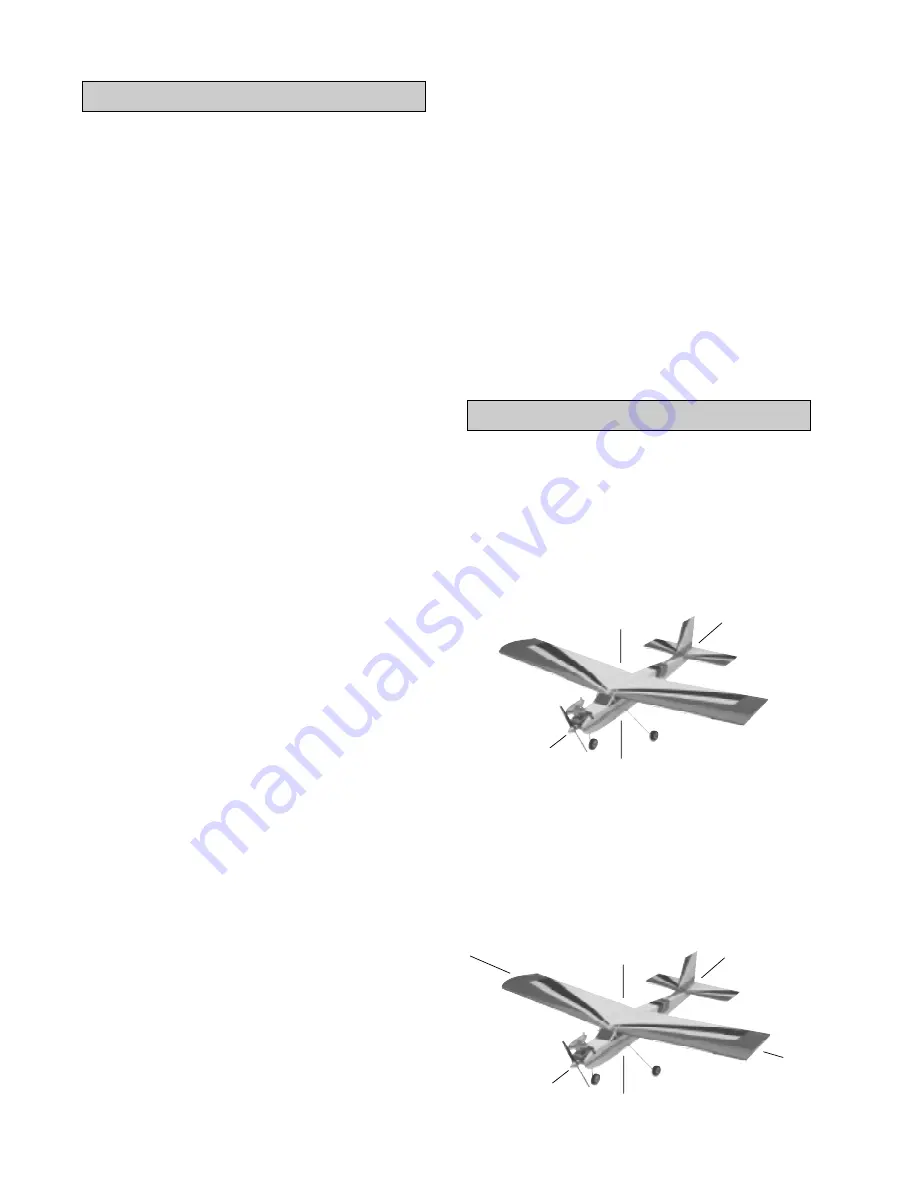
28
ABC's of FLYING
If you've come this far, now you're ready to pre-
pare for the maiden voyage of your new Right Flyer
40T Mk.II. Before proceeding, we highly recommend
double checking all of your work. Make sure there is
no detail you missed and that you understand all of
the airplane's functions. We hope you find the fol-
lowing sections helpful, making your first flights
successful.
Since you've chosen the Right Flyer 40T Mk.II,
you've avoided the most common mistake beginners
make: choosing a high performance airplane like the
a P-51 Mustang or a F-16 jet as a trainer. Just as you
wouldn't learn to drive a car using an Indy car, learn-
ing to fly airplanes should start in a trainer. The second
mistake new pilots make is not seeking out the help
of an experienced modeler. While it is certainly true
that some people have learned to fly without help,
having the help of an experienced R/C model pilot
will help make those first few flights much more suc-
cessful and enjoyable. So, we highly recommend
seeking out a club or a flying field near you. You'd
be surprised just how many clubs there are that help
beginners.
Once at the field, even before removing your air-
plane from the car, introduce yourself to some of the
other pilots. Find out what safety procedures and fre-
quency control system is in place. In short, learn and
follow the field etiquette. Doing so will ensure safe
modeling for you and others. You will also be able to
find out who might be the right person to help you
learn to fly.
Sometimes, it is just impossible to find anyone to
help. In that case it would be wise to seek out some
additional information about flying. R/C Modeler,
Harry Higley and Model Airplane News all publish
very good basic flight training books that explain fly-
ing in greater depth. You may also wish to seek out a
computer simulator. Great Planes and Dave Brown
both make excellent flight simulators that can be very
effective at teaching the basic coordination of R/C
flight.
If you do decide you have no choice but to learn to
fly on your own, choosing the place to fly your new
airplane is of the utmost importance. Select your po-
tential flying field with the following considerations:
1) Look for a long, wide runway. The bigger it
is, the easier it is to find when landing. Optimum
sites are large grass fields and dry lake beds.
2) The fewer the ground obstructions the bet-
ter! No close trees, small hills, large rocks or buildings
should be nearby.
To begin you should know how the Right Flyer
40T Mk.II operates. First, there are four forces oper-
ating on a flying aircraft: Lift, Weight, Thrust and
Drag. The engine will create thrust to overcome the
drag. In times when the engine is off, gravity pulling
the plane down can act as thrust (how gliders work).
The wing flies through the air as a result of the thrust
and causes lift to overcome the weight of the aircraft.
BASICS of FLIGHT
Controlling the Right Flyer 40T Mk.II
Flying is three dimensional, therefore, all aircraft
operate on three axis: roll, yaw and pitch. Roll is the
wing tips raising and lowering. Yaw is the nose mov-
ing from right to left. Pitch is seen as the nose moving
up and down. Maintaining flight is the act of over-
coming weight and drag with lift and thrust while
properly controlling all three axis.
3) While R/C flying is generally safe, it can lead
to serious harm or injury. Do not try to fly your model
if there are any houses or people nearby.
4) The takeoff surface should be short grass,
hard packed dirt, concrete or asphalt. The surface
should be smooth and free from any small rocks or
holes. You don't want anything to interfere with the
plane as you taxi, takeoff and land.
5) No high-lines, telephone lines or electrical
lines should be near the flying site. If your plane
accidentally does fly into wires of some kind do not
try to retrieve it yourself! Serious injury or even death
could result. Contact the local police or fire depart-
ment. They can send somebody to help you retrieve
the airplane safely.
Drag
Lift
Weight
Thrust
Roll
Yaw
Pitch









































